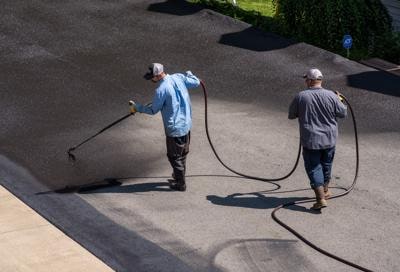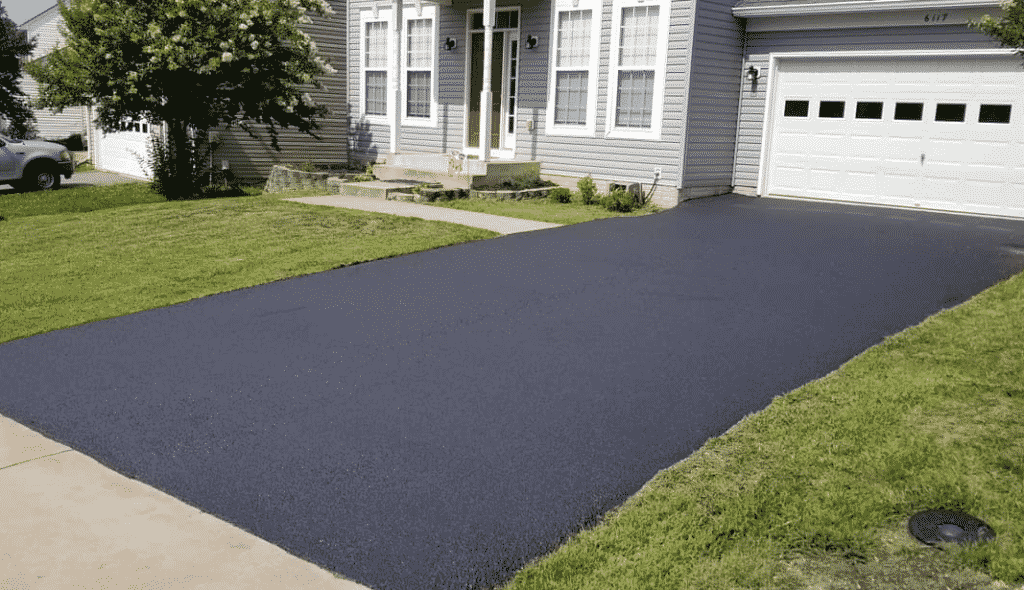Release the Prospective: Regrading and Asphalt Sealing for Commercial Spaces
Wiki Article
Hot Mix Asphalt: A Lasting Service for Sidewalk
Hot Mix Asphalt (HMA) has arised as a leading sustainable option for sidewalk services, offering a myriad of ecological benefits and cutting-edge innovations. As the need for eco-friendly building and construction methods expands, exploring the subtleties of HMA's sustainability can provide important understandings into the future of pavement remedies.Environmental Benefits of Hot Mix Asphalt

Furthermore, Hot Mix Asphalt assists to alleviate urban warm island effects. Its dark shade takes in sunshine, lowering the amount of heat mirrored back into the environment contrasted to lighter-colored sidewalks. This can decrease ambient temperatures in city locations, decreasing the need for a/c and inevitably reducing power usage.
Furthermore, Warm Mix Asphalt adds to boosted stormwater administration. Its porous nature allows water to infiltrate the sidewalk and recharge groundwater supplies, decreasing overflow and the threat of flooding. These ecological benefits make Hot Mix Asphalt a sustainable choice for paving roads and freeways.
Energy Efficiency in HMA Production
Is energy effectiveness a critical variable in the manufacturing of Warm Mix Asphalt (HMA)? Power plays a significant role in the manufacturing of HMA, influencing both expense and environmental sustainability. One key facet of energy efficiency in HMA manufacturing is the use of warm mix asphalt (WMA) innovations.Moreover, improvements in plant modern technologies have led to even more energy-efficient HMA production processes. By maximizing energy usage in HMA manufacturing, the sector can decrease its carbon footprint while keeping high-grade sidewalk products.
Recyclability of Hot Mix Asphalt
The recyclability of Warm Mix Asphalt (HMA) is an essential element of its sustainability and long-term environmental impact. HMA is just one of the most recycled products in the United States, with over 100 million lots of redeemed asphalt pavement (RAP) being reused each year in brand-new sidewalk construction. Reusing HMA uses several ecological advantages, such as minimizing the demand for virgin products, decreasing energy consumption during production, and lowering the amount of waste sent out to land fills.The process of recycling HMA involves grating the existing sidewalk, squashing it right into smaller sized items, and blending it with brand-new aggregate and asphalt binder to create a recycled mix. This recycled mix can typically execute in addition to and even much better than conventional HMA, while calling for less basic materials and creating reduced greenhouse gas discharges. By including RAP right into brand-new sidewalk tasks, road firms can conserve natural sources, decrease prices, and reduce the ecological footprint of road building and construction and maintenance activities. In general, the recyclability of HMA plays a considerable function in advertising sustainable techniques within the pavement sector.

Long-Term Performance of HMA
Asphalt sidewalks demonstrate longevity and strength over a prolonged duration, mirroring the lasting performance of Hot Mix Asphalt (HMA) The longevity of HMA can be credited to its capability to endure rush hour loads, harsh climate condition, and the effects of aging. Studies have actually revealed that properly designed and correctly created HMA pavements can last for two decades or more with regular maintenance. The trick to making the most of the long-term performance of HMA hinges on making use of high-grade products, following finest methods in construction, and applying reliable upkeep strategies. Proper drainage, routine examinations, and timely repairs are necessary for preserving the structural stability of HMA sidewalks over time. Additionally, innovations in HMA modern technology, such as making use this post of polymer-modified binders and warm mix asphalt, have better enhanced the resilience and longevity of HMA sidewalks. By prioritizing top quality building and upkeep methods, HMA remains to confirm itself as a economical and lasting remedy for long-lasting pavement infrastructure.
HMA: Sturdiness and Sustainability
Demonstrating both longevity and sustainability, Warm Mix Asphalt (HMA) has actually come to be a cornerstone in the construction of durable pavement facilities - angled parking. HMA's durability comes from its capability to stand up to hefty tons, extreme climate condition, and high web traffic volumes, making it a reputable selection for roadways, highways, and airport terminal runways. The structure of HMA, which commonly consists of accumulations, binder, and filler, plays a vital function in boosting its long life and resistance to tear and hot mix asphalt wear
Moreover, HMA's sustainability depends on its recyclability and energy-efficient production procedure. The ability to reuse reclaimed asphalt pavement (RAP) in new HMA mixes decreases the demand for virgin materials and lessens the ecological effect of sidewalk building and upkeep. Furthermore, the energy performance of generating HMA depends on its reduced blending temperature levels compared to various other sidewalk products, bring about reduced power consumption and greenhouse gas emissions.
Final Thought
In verdict, hot mix asphalt (HMA) provides a lasting remedy for sidewalk with its eco pleasant characteristics. HMA's recyclability, power performance in production, and long-term durability make it an eco-friendly selection for roadway construction.
HMA is one of the most recycled products in you can try this out the United States, with over 100 million heaps of recovered asphalt sidewalk (RAP) being recycled annually in brand-new pavement building and construction.The process of reusing HMA includes milling the existing sidewalk, crushing it right into smaller items, and mixing it with brand-new aggregate and asphalt binder to develop a recycled mix.Asphalt pavements show resilience and strength over a prolonged duration, showing the long-term performance of Warm Mix Asphalt (HMA) Additionally, innovations in HMA innovation, such as the usage of polymer-modified binders and warm mix asphalt, have actually even more boosted the resilience and long life of HMA pavements. The capability to reuse recovered asphalt sidewalk (RAP) in new HMA combinations minimizes the demand for virgin products and minimizes the ecological impact of sidewalk construction and upkeep.
Report this wiki page